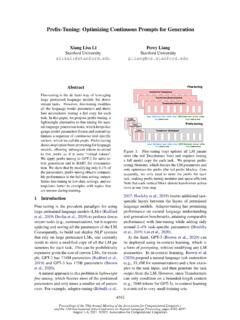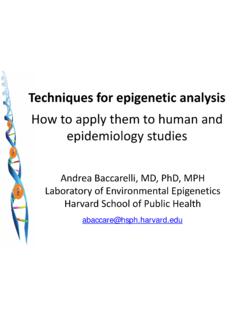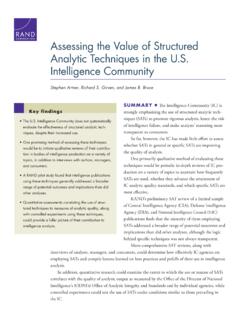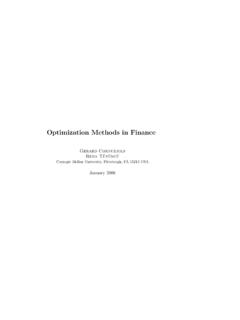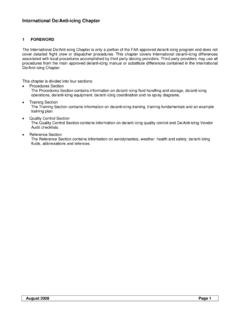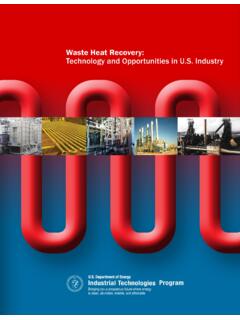Transcription of Molecular techniques in clinical microbiology
1 - 1 - Molecular techniques in clinical microbiology Molecular biology is the science of biomolecules. Even though the term biomolecules includes all molecules such as proteins, fatty acids etc, it is refers to nucleic acid these days. The application of Molecular technology in medicine is almost endless, some of the applications of Molecular methods are: 1. Classification of organism based on genetic relatedness (genotyping) 2. Identification and confirmation of isolate obtained from culture 3. Early detection of pathogens in clinical specimen 4. Rapid detection of antibiotic resistance 5. Detection of mutations 6.
2 Differentiation of toxigenic from non-toxigenic strains 7. Detection of microorganisms that lose viability during transport, impossible, dangerous and costly to culture, grow slowly or present in extremely small numbers in clinical specimen 8. Apart from their role in microbiology , these techniques can also be used in identifying abnormalities in human and forensic medicine. The various Molecular techniques include: 1. Plasmid profiling 2. mol% G+C content 3. Nucleotide sequencing 4. Restriction fragment length profiling (RFLP) 5. Pulse field Gel electrophoresis (PFGE) 6. Nucleic acid hybridization 7.
3 Amplification techniques (signal amplification, probe amplification & target amplification) 1. PLASMID PROFILING Plasmids are extrachomosomal circular double stranded DNA found in most bacteria. Each bacterium may contain one or several plasmids. - 2 - Plasmid profile analysis involves study of size and number of plasmids. After the cells are lysed, the nucleic acids are subjected to electrophoresis. This gives the size and number of plasmids present in the cells. Since some species may contain variable number of plasmids or even unrelated bacteria may harbour similar number of plasmids, plasmid profiling may not provide useful information.
4 2. Mol % G+C content DNA is a helical structure with AT and GC base pairs held by hydrogen bonds. When the solution of double strand DNA (dsDNA) is heated to near boiling temperature, the two complimentary strands separate. This is called denaturation or melting. The melting temperature of a particular DNA sequence is determined by its nucleotide composition. Because of three hydrogen bonds between G and C, DNA that has relatively high GC content require more energy to denature than DNA with higher AT content. At a wavelength of 260 nm DNA absorbs light and the melting process can be monitored by continuous measurement of optical absorbance at this wavelength.
5 As the temperature is raised, the complementary strands disassociate resulting in increase in absorbance until the two strands are completely separated. A curve is drawn noting the time on x axis and temperature with absorbance on y axis. The mid point of the curve represents the temperature at which half of the base pairs have separated. This temperature Tm is the function of mol%G+C content of DNA. The base composition of DNA from bacteria range from 25-75 moles percent guanine + cytosine (mol% G+C). If the mol% G+C of two organisms differ widely then it is more likely that the two are unrelated.
6 If the mol% G+C values of two isolates are identical, then it is likely that the two are similar or related. It is also possible that the two isolates are unrelated but coincidentally have similar G+C ratio. This method was in use earlier to study phylogenetic relationship amongst bacteria. Due to ambiguity of the interpretation and the availability of more specific techniques (such as rRNA homology), this is no longer used in classification. 3. Nucleotide sequencing: This method involves the determination of nucleotide sequence in the given DNA molecule. There are two popular methods for sequencing DNA; Chemical Clevage Method and Chain Terminator Method.
7 Both these methods have now been automated and the sequence can be read using a computer. Since it is time consuming process, it does not much role in diagnostic microbiology . This technique can be used to study the structure of gene, detect mutations, compare genetic relatedness and to design oligonucleotide primers. 4. Restriction fragment length polymorphism (RFLP) Polymorphism (or variability) in nucleotide sequence is present in all organism including microbes. RFLP technique relies on the base pair changes in restriction sites, which arise due to mutations. Restriction sites are strands of DNA that are specifically recognized and cleaved by restriction endonucleases.
8 Some enzymes cleave segment away from restriction sites and some within the sites. Restriction site sequences range from 4-12 bases in length. When cleaved by the specific endonuclease enzyme, the average length of the fragment obtained is determined in part by the base pair recognized by the enzyme. In general restriction enzymes recognizes 4, 6 or 8 base sequence. Recognition of 4 bp sequence yields fragments with average length of 250 bp, that of 6 bp yields fragment of 4000 bp and the enzyme that recognizes 8 bp sequence generates fragments of approximately 64000 bp in length. Thus, the enzyme that recognizes 4 bp sequence produces more short fragments.
9 Once the desired target DNA (bacterial chromosome, plasmid or of any origin) is cut using known or randomly selected restriction enzyme, the resultant fragments are separated by electrophoresis on agarose or polyacrylamide gel. Upon separation on gel, the fragments can be visualized as bands after staining with ethidium bromide (which binds to dsDNA) and viewed under uv light. Depending on the - 3 - numbers of fragment and their sizes either discrete or overlapping bands are seen. These bands can be transferred to nylon membranes for hybridization. This technique is very useful as a epidemiological typing tool as it can be used to type isolates.
10 The DNA of two or more isolates are subjected to digestion by the same restriction endonuclease enzyme, the fragments are separated by electrophoresis and the bands are compared. This process is also known as DNA fingerprinting and makes it very useful tool in forensic medicine. Another important application is the ribotyping. The 16s rRNA (~1500 bp) is the smaller subunit of the bacterial ribosome is said to be most conserved sequence. It has a constant sequence that is common to most microorganisms and a variable sequence that is unique to a specific genus or species. Such sequences can be subjected to RFLP to determine relatedness with other organisms and can be confirmed by following with southern blotting.




